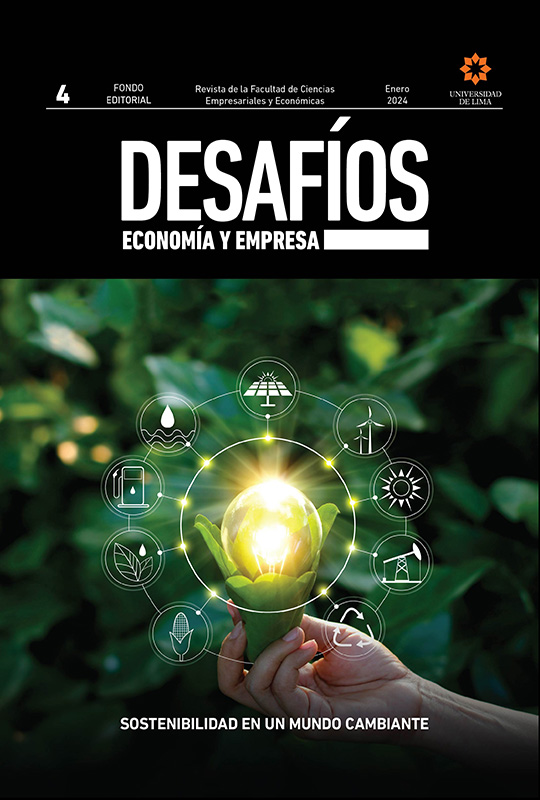Determinantes del capital humano desde la perspectiva de la innovación y el desarrollo tecnológico para América Latina
DOI:
https://doi.org/10.26439/ddee2024.n04.6280Palabras clave:
capital humano, innovación, tecnología, países latinoamericanos, datos de panelResumen
Este estudio examina los factores que influyen en el capital humano desde una perspectiva de innovación y desarrollo tecnológico en ocho países emergentes de América Latina: Argentina, Brasil, Chile, Colombia, Ecuador, México, Perú y Uruguay. Utilizando datos de panel y un modelo de efectos fijos, el análisis de regresión incluye variables como el uso del internet, patentes, banda ancha fija, propiedad intelectual y artículos científicos. Los resultados demuestran que todas las variables tienen un impacto estadísticamente significativo y positivo en el capital humano. Internet, banda ancha y patentes son especialmente relevantes, ya que presentan los coeficientes más altos. Esto subraya la importancia de aprovechar los avances tecnológicos, medidos a través del acceso al internet y la conectividad de banda ancha, para el desarrollo de un capital humano capacitado. Además, se destaca la importancia de la innovación continua, especialmente a través de patentes, en el fortalecimiento del capital humano. A partir de estos hallazgos, se sugiere que los Gobiernos implementen políticas que promuevan la innovación en la sociedad y la adopción de nuevas tecnologías para mejorar los niveles de productividad.
Descargas
Referencias
Acheampong, A. O., Opoku, E. E. O., Dzator, J., & Kufuor, N. K. (2022). Enhancing human development in developing regions: do ICT and transport infrastructure matter? Technological Forecasting and Social Change, 180. https://doi.org/10.1016/j.techfore.2022.121725
Becker, G. S. (1964). Human capital: a theoretical and empirical analysis with special reference to education. Columbia University Press.
Becker, G. S. (1993). Nobel lecture: the economic way of looking at behavior. Journal of Political Economy, 101(3), 385-409. https://www.jstor.org/stable/2138769
Bollen, L., Vergauwen, P., & Schnieders, S. (2005). Linking intellectual capital and intellectual property to company performance. Management Decision, 43(9), 1161-1185. https://doi.org/10.1108/00251740510626254
Breusch, T., & Pagan, A. (1980). The Lagrange multiplier test and its applications to model specification in econometrics. The Review of Economic Studies, 47(1), 239-253. https://doi.org/10.2307/2297111
Carrasco, A. S. E. (2001). Los retornos de la inversión en capital humano en Bolivia. Revista Análisis Económico UDAPE, 19, 1-26. https://www.udape.gob.bo/portales_html/analisisEconomico/analisis/vol19/art01.pdf
Clarke, P., Crawford, C., Steele, F., & Vignoles, F. (2010). The choice between fixed and random effects models: some considerations for educational research. IZA
Discussion Paper, (5287). https://docs.iza.org/dp5287.pdf
Crosby, M. (2000). Patents, innovation and growth. Economic Record, 76(234), 255-262. https://doi.org/10.1111/j.1475-4932.2000.tb00021.x
Faggian, A., & McCann, P. (2008). Human capital, graduate, migration and innovation in British regions. Cambridge Journal of Economics, 33(2), 317-333. https://www.jstor.org/stable/23601804
Griffith, A. S., & Altinay, Z. (2020). A framework to assess higher education faculty workload in US universities. Innovations in Education and Teaching International, 57(6), 691-700. https://www.tandfonline.com/doi/abs/10.1080/14703297.2020.1786432
Hagsten, E. (2015). Broadband connected employees and labour productivity: a comparative analysis of 14 European countries based on distributed microdata access. Economics of Innovation and New Technology, 25(6), 613-629. https://doi.org/10.1080/10438599.2015.1105547
Haini, H. (2019). Internet penetration, human capital and economic growth in the ASEAN economies: evidence from a translog production function. Applied Economics Letters, 26(21), 1774-1778. https://doi.org/10.1080/13504851.2019.1597250
Haller, S. A., & Lyons, S. (2015). Broadband adoption and firm productivity: evidence from Irish manufacturing firms. Telecommunications Policy, 39(1), 1-13. https://doi.org/10.1016/j.telpol.2014.10.003
Hausman, J. (1978). Specification tests in econometrics. Econometrica, 46(6), 1251-1271. https://doi.org/10.2307/1913827
Huang, Y., & Jim Wu, Y. (2010). Intellectual capital and knowledge productivity: the Taiwan biotech industry. Management Decision, 48(4), 580-599. https://doi.org/10.1108/00251741011041364
Iossifova, A. (2008). Research productivity, teaching relevance, and AACSB accreditation. Quality Management Journal, 15(4), 46-56. https://doi.org/10.1080/10686967.2008.11918204
Jiménez, M., Matus, J., & Martínez, M. (2014). Economic growth as a function of human capital, internet and work. Applied Economics, 46(26), 3202-3210. https://doi.org/10.1080/00036846.2014.925079
Mack, E., & Faggian, A. (2013). Productivity and broadband. International Regional Science Review, 36(3), 392-423. https://doi.org/10.1177/0160017612471191
Malamud, O., & Pop-Eleches, C. (2011). Home computer use and the development of human capital. The Quarterly Journal of Economics, 126(2), 987-1027. https://doi.org/10.1093/qje/qjr008
Malamud, O. (2019). The effect of home computers and the internet on children’s human capital development. DICE Report, 17(2), 34-40. https://ideas.repec.org/a/ces/ifodic/v17y2019i02p34-40.html
Maskus, K. E., & McDaniel, C. (1999). Impacts of the Japanese patent system on productivity growth. Japan and the World Economy, 11(4), 557-574. https://doi.org/10.1016/S0922-1425(99)00012-2
Mincer, J. (1974). Schooling experience and earnings. National Bureau Economics Research.
Nelson, R., & Phelps, E. (1966). Investment in humans, technology diffusion, and economic growth. American Economic Review, 56, 142-147. https://ideas.repec.org/p/cwl/cwldpp/189.html
Noser, T. C., Manakyan, H., & Tanner, J. R. (1996). Research productivity and perceived teaching effectiveness: a survey of economics faculty. Research in Higher Education, 37(3), 199-221. https://doi.org/10.1007/BF01730119
Owusu-Agyei, S., Okafor, G., Chijoke-Mgbame, A. M., Ohalehi, P., & Hasan, F. (2020). Internet adoption and financial development in sub-Saharan Africa. Technological Forecasting and Social Change, 161. https://doi.org/10.1016/j.techfore.2020.120293
Paul, C. W., & Rubin, P. C. (1984). Teaching and research: the human capital paradigm. The Journal of Economic Education, 15(2), 142-147. https://doi.org/10.1080/00220485.1984.10845062
Rojas, M., Angulo, H., & Velásquez, I. (2000). Rentabilidad de la inversión en capital humano en México. Economía Mexicana. Nueva Época, 9(2), 113-142. http://www.economiamexicana.cide.edu/num_anteriores/IX-2/01_MARIANO_ROJAS_113-142.pdf
Schultz, T. W. (1993). The economic importance of the human capital in modernization. Education Economics, 1(1), 13-19. https://doi.org/10.1080/09645299300000003
Verbeek, M. (2005). Models based on panel data. A Guide to modern econometrics. Wiley.
Wooldridge, J. M. (1994). Estimation and inference of dependent processes. Handbook of Econometrics, 4, 2639-2738. https://doi.org/10.1016/S1573-4412(05)80014-5
Yang, G., Wang, F., Huang, X., & Chen, H. (2022). Human capital inflow, firm innovation and patent mix. Journal of Asian Economics, 79. https://doi.org/10.1016/j.asieco.2021.101439
Young, B. (2006). A study on the effect of internet use and social capital on the academic performance. Development and Society, 35(1), 107-123. https://hdl.handle.net/10371/86685
Zahedi, M., Hosnavi, R., & Kangogar, A. (2016). Linking intellectual capital and intellectual property to company performance. Management Science Letters, 6(12), 753-758. https://doi.org/10.5267/j.msl.2016.10.005



